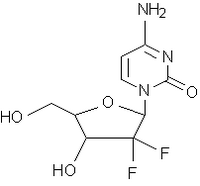Purpose: Case 1: A 69 years old man had an extensive NSCLC. Gemcitabine (800 mg/m2) and vinorelbine (25 mg/m2) were given weekly. 7 days after the ninth dose, he developed dry cough, tachypnea (30/mn), cyanosis and bilateral crackles with hypoxaemia (45 mmHg) and diffuse interstitial infiltrates on CT scan. Blood and BAL cultures, serology for mycoplasma, legionella and viruses were negative. Antibiotics (ceftazidime, amikacine trimethoprim) were started without clinical effect. Hypoxaemia became refractory to oxygen therapy with extension of interstitial infiltrates; the patient died 20 days after admission. Case 2: A 68 years old man had an metastatic NSCLC. Gemcitabine and vinorelbine were started according the same weekly scheme. After the tenth dose, the patient developed fever and crackles over the right lung field. Antibiotics were given and chemotherapy was interrupted. A week later, an ARDS occured with refractory hypoxaemia and diffuse interstitial infiltrates on CT scan. Mechanical ventilation and parenteral corticotherapy were immediately started: pulmonary infiltrates were resolved within a few days, but the patient died because pulmonary embolism. Gemcitabine is an analog of deoxycytine with significant activity against solid tumors. Transient dyspnoea has been reported in less 10 % of patients after the infusion, secondary to mild bronchospasm. Recently pulmonary toxicity with interstitial infiltrates and respiratory failure resulting from treatment with gemcitabine has been described in 6 published cases, with pathological findings consistant with diffuse alveolar damage, intra alveolar odema with interstitial inflammation. It was postulated that the pathogenesis is a capillary leak syndrome, such as that seen with another nucleotid analog, cytosine arabinoside, which is structurally similar. It is important to recognize this pulmonary toxicity because it seems that corticosteroid therapy at an early stage could be effective.
Jean L Breton, MD(*); F Alfreijat, MD and I Guy, MD. General Hospital, Belfort, France.
COPYRIGHT 1999 American College of Chest Physicians
COPYRIGHT 2000 Gale Group



